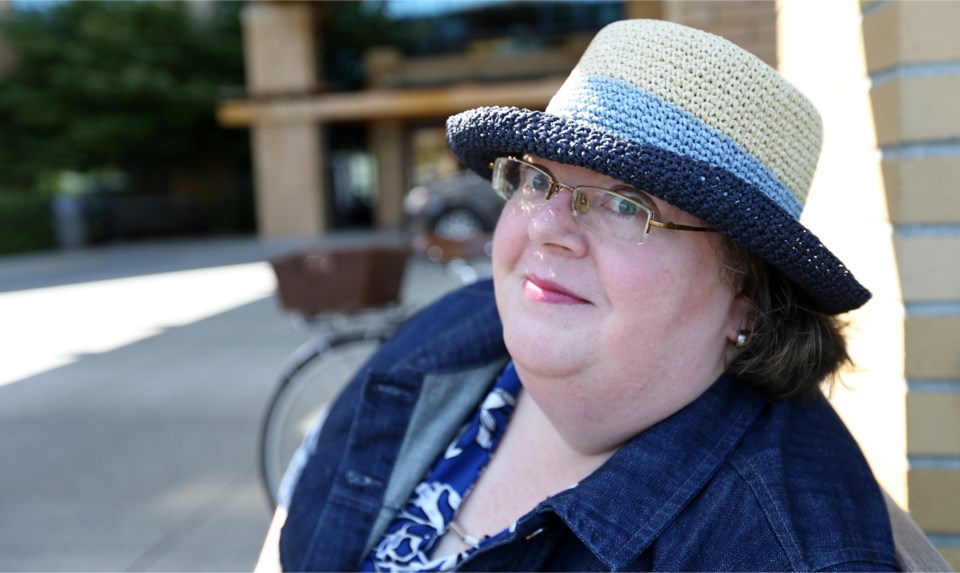A Victoria woman undergoing cancer treatment says the 15-week maximum for medical employment insurance is too short and outdated.
“There’s this gap between medical EI and any private plans or long-term disability benefits,” said Mary Katharine Ross, who is off work from her job at a local non-profit organization.
Ross said the federal program’s 15-week maximum falls short of what many people with illnesses such as cancer need and is not in line with other EI coverage.
Sickness benefits have remained at 15 weeks since 1971, when they were introduced, along with maternity benefits, as part of a major overhaul of EI.
Since then, maternity benefits — now called parental benefits — have increased to 35 weeks. Regular benefits are 45 to 50 weeks, while compassionate-care benefits were recently extended to 26 weeks. Canada also just introduced extended benefits in areas suffering economic hardship, such as Fort McMurray.
Ross had a kiwi-sized tumour removed from behind her eye in April and has been waiting for and undergoing treatment since. Her doctor said she should take at least six months off work, but she was shocked to discover that the EI program covers medical leaves for a maximum of 15 weeks.
“I was so naive,” she said. “I thought I’d be assured 15 weeks and then be able to reapply as long as I was in treatment.”
In fact, after 15 weeks, she would have to apply for income assistance through her employer’s private health plan or long-term disability benefits through the Canada Pension Plan.
“These can take weeks or months and there are no guarantees,” Ross said. “There’s this gap and it’s really scary.”
In the midst of her cancer treatment, she found herself researching EI and reaching out to local politicians.
“It was very stressful,” said Ross, who will have about six weeks with no income as she goes through radiation treatment, since that’s the gap between the end of her medical EI and her employer plan kicking in.
“I’m lucky. If I didn’t have employer insurance, I’d be screwed,” said Ross, who considered cashing an RRSP and putting her stuff in storage and staying with friends if she had to.
Kelly Newhook from Together Against Poverty Society said numerous clients have ended up in poverty after struggling to cope with an illness and the sudden loss of income. “If you don’t have long-term disability through your work, you’re hooped,” Newhook said.
Disability advocate Kevin Love said the limited time period for sickness benefits is especially unfair for people who want to go back to work but need more time to recover. “This is a well-known limitation of the EI system and it needs to change,” he said.
In 2009, Michael Prince, Landsdowne professor of social policy at the University of Victoria, published a report on the special benefits in the federal EI program. He was initially approached by Paul Martin’s Liberal government.
“They were getting heart-wrenching letters from people who had paid into employment insurance but then exhausted it at 15 weeks,” said Prince. By the time his report was published, the Conservatives under Stephen Harper were in power.
In the report he presented to the government, Prince wrote: “With respect to the sickness benefit, about one-third of claimants every year exhaust the maximum of 15 weeks and it is not entirely evident what happens to them in terms of income protection or instability.”
He said there is a lack of data on what happens to people who use up the 15-week maximum.
“Were they still sick? What did they do for income?” he asked. “Anecdotally, some people end up on welfare, using up RRSPs and downsizing.”
The sickness benefit came up again in 2012, when an NDP member of Parliament introduced a private member’s bill to extend the maximum number of weeks to 50 from 15 and eliminate a two-week waiting period for those with serious illnesses and injuries.
All NDP and Liberal MPs voted in favour of the bill, but with Conservative members opposing it, it failed to pass.
In discussion of the bill, a Quebec woman battling thyroid cancer for the third time in five years presented a petition with 430,000 signatures asking for the sickness benefits to be extended.
One of the campaign promises of Prime Minister Justin Trudeau, whose father’s government introduced special benefits such as sickness and maternity under employment insurance in 1971, was to improve the EI program.
But a spokesperson for Employment and Social Development Canada said extending sickness benefits will not be included in changes to the employment insurance program outlined in the 2016 federal budget.
“We closely monitor the proportion of claimants that use all of their EI sickness benefits to ensure EI is there for Canadians who need help the most, when they need it,” said the spokesperson, noting the average duration of sickness benefits is 10 weeks.
The statement said the EI program encourages the delivery of sickness benefits by private-sector employers, adding that employers offering sickness benefits can qualify for premium reductions.
Ross said the government’s response is disappointing and puts people like her under stress when they should be focusing on healing.
“It’s one of those things where you don’t realize there’s a deficiency until it touches you personally,” she said.



